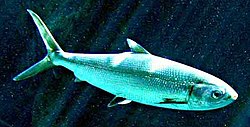| Chanidae Temporal range: | |
|---|---|
 | |
| Chanos chanos | |
 | |
| 110 million year old fossil † Dastilbe from Brazil | |
| Scientific classification | |
| Kingdom: | Animalia |
| Phylum: | Chordata |
| Class: | Actinopterygii |
| Order: | Gonorynchiformes |
| Family: | Chanidae Günther, 1868 [1] |
| Type genus | |
| Chanos | |
| Subfamilies | |
| |
Chanidae is a family of fishes which has a number of fossil genera and one monotypic extant genus which contains the milkfish (Chanos chanos). [3]